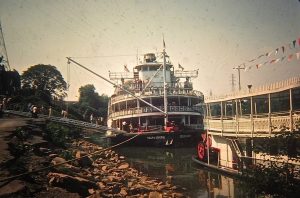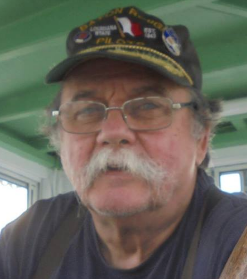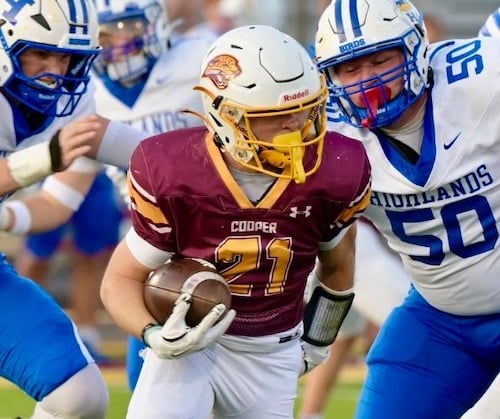The riverboat captain is a storyteller, and Captain Don Sanders will be sharing the stories of his long association with the river — from discovery to a way of love and life. This a part of a long and continuing story.
By Captain Don Sanders
Special to NKyTribune
Fifty years ago this week, on Monday, May 24th, 1971, at 6:05 p.m., the DELTA QUEEN departed the Cincinnati Public Landing for Nashville, Tennessee, on the Cumberland River with 122 passengers on board. Happily for my recollection, the days of the week on the 1971 calendar correspond with this year’s dates.

The QUEEN’s usual master, Captain Ernest E. Wagner, took off that trip; so Captain Harry Louden was the bossman. Captain Art Zimmer piloted on the front watch while Captain “Handsome Harry” Hamilton “stood” the back watch. I was the First Mate standing watch opposite Cap’n Louden. Second Mate Jim, not yet “Captain,” Blum was on duty with the Skipper.
By twenty minutes past midnight, the steamboat approached Markland Dam. Twenty-five minutes later, she was downbound with 16.6 feet and falling, recorded on the lower guage on the downstream side of the dam. At 03:05 am, a single, solitary car parked on the landing at Madison, Indiana, blinked its headlights begging for a whistle salute in return. But with only the most necessary crew and few guests awake, Captain Hamilton ignored the greeting and stared ahead into the darkness at the flashing lights on the smokestacks of the Clifty Creek powerplant below the town.

Captain Hamilton always arrived for duty snazzily dressed. Usually, he wore a tie with a neatly pressed shirt and sharply-creased dress trousers. His peers called him “Handsome Harry,” but not in his presence. In his younger days, Harry steered on the largest steam towboat of all times, the legendary steamer SPRAGUE when Standard Oil owned her. Captain Fred Way’s “Steam Towboat Directory” lists a Captain Charles Hamilton on “Big Momma,” as the leviathan riverboat was known in the 1920s. Still, Harry was yet to earn his stripes as one of the more celebrated Lower River pilots when Cap’n Charles was in the wheelhouse. For all I know, Harry and Charles Hamilton were related. That’s the way most steamboat pilots got their start in those days. Few fledgling steersmen began their careers on deck. Piloting jobs often went from fathers to sons.
Bethlehem, Indiana, Mile 574.7. or so, passed to starboard around 4 am. Another old-timer I worked within the early 1970s, Captain Albert Sidney “Bow Wow” Kelley, a pilot on the sidewheel packet, CITY OF LOUISVILLE, in his youth before the CITY “went under the ice” during the dreadful winter of February 1918, told me of growing up on his family farm at Kelley’s Landing on the Kentucky side of the Ohio River across from Bethlehem. When still a youngster, his mother often sent him to the riverbank lugging a large wicker basket shortly before the usual time the swift steamboat, he would one day pilot, came charging upstream toward Cincinnati. The Ohio was so shallow and narrow in the early 20th Century, Kelley recalled, the CITY OF LOUISVILLE sucked the water clean off the riverbank and stranded incalculable numbers of fish in its passing. Young Kelley would then rush madly along the shore filling his basket for the evening meal before the water came rushing madly back to seek its former level.

By 8 a.m, Captain Louden guided Captain Art Zimmer as the DELTA QUEEN softly nudged against the aging World War Two landing craft Sinclair Oil used for a floating dock. Originally, the dock belonged to the Stoll Oil Company of Louisville. Captain Charles William “CW” Stoll remained a legend on the Ohio River to this day. During the war years, the United States Coast Guard commissioned CW as an officer into their service. He helped deliver LSTs and other warships down the Ohio from shipyards along the river. CW was also pals with Captain Tom Greene and stood watch on the DELTA QUEEN soon after Captain Tom brought the boat from California by way of the Panama Canal. My first landing at the Sinclair Dock was while I decked aboard the excursion steamer AVALON in the 1959 and the ‘60 seasons. Several times, a decade later, as the First Mate and/or Captain of the QUEEN, I brought the ponderous steamboat deftly alongside the delicate landing craft and thrilled to each experience.
Topped off with heavy Bunker-C Fuel Oil and with the freshwater tanks full, the DELTA QUEEN ignored Louisville, entered McAlpine Lock, and passed beyond the Falls of the Ohio River before noon. The entry for 12 pm, written in my hand, noted:
“Indiana Public Service Light. Mile 610.0. {Partly cloudy, windy. 3.2 mph.}”
Lock 43 soon arrived, and the QUEEN departed by 2:05 pm with 14-feet and falling on the guage.

At Locks 44 and 45, the DELTA QUEEN passed over the retracted “wickets” of the collapsible dams since lowered as the level of the river raised high enough that the dams could be “thrown.” Commercial and pleasure boat river traffic would then pass unimpeded until the water level fell to the stage where the sections of the dams (wickets) required raising.
Then once again, traffic used the locks to bypass the newly reformed dams.
After passing Lock 44, Leavenworth, Indiana, ahead lay the exciting “oxbow bends” of the Ohio where the river twists and turns on itself within the deep canyon-like walls of the river valley.
Captain Art Zimmer and my father, Lt. Col. Jess Sanders, Jr., became instant friends as soon as they met. Cap’n Art was a St. Louis motorcycle cop before piloting took him to the riverboats. Dad, at that time, was the Chief of Detectives for the Covington, Kentucky PD, and, naturally, they became “brothers of the blue.” Whenever the two were together, usually in the pilothouse of the QUEEN, they talked “cop shop” endlessly, it seemed. Captain Zimmer may have started on the river with the Streckfus Steamers in his hometown, but I know that he and Cap’n Louden were the first pilots on the MISSISSIPPI QUEEN when that troubled steamboat first started cruising five years after the Nashville trip.

As the Cannelton Dam was not completed in its entirety, the DELTA QUEEN still had to use the lock to bypass the dam still under construction. The Log shows the lockage took only ten minutes to enter and depart – a clear indication there was not much water impounded behind Cannelton Dam.
At 1:25 a.m., the boat arrived at Lock and Dam # 46 below Owensboro, Kentucky, and was on her way again within 15 minutes. Two hours later, The DELTA QUEEN passed Lock 47, where two grounded tows impatiently waited above the lock for the Engineers to raise the wickets so the towboat and barges could float off the ground.
By the time the Forward Watch came on at 6 a.m., Captain Hamilton and I had the QUEEN landed at Evansville, Indiana, with the potable water lines run ashore to the closest fire hydrant filling the drinking water tanks. Much of the garbage and trash was ashore and dumped into the 20-yard container waiting for our arrival when the next shift relieved us. I’d already eaten breakfast and was in my room in the Officers’ Quarters on the Forward Sun Deck when the whistle blew at 6:50 am for departure.
At 11 o’clock, the General Alarm bells and the boat’s three-chime Lunkheimer whistle knocked me out of bed.
“FIRE DRILL… FIRE DRILL… FIRE DRILL…” they shrilly screamed in unison.
“MAN OVERBOARD DRILL… MAN OVERBOARD DRILL… All Personnel Report to Their Duty Stations.”
Following three more locks and a three-hour layover at Paducah, Kentucky, the QUEEN entered the Tennessee River at 10:30 p.m. By 6 a.m. the next morning, Thursday, May 27, 1971, Handsome Harry and I had the boat through Kentucky Dam Lock and made fast at Kentucky Dam Village State Park, across the broad lake behind the dam. At nine that evening, the DELTA QUEEN departed Kentucky Dam Village in tow with the M/V EDWARD H. piloted by Captain T. Smith.

At 9:45 p.m., we entered Barkley Canal, connecting the Tennessee and Cumberland Rivers. Fifteen minutes later, the DELTA QUEEN was on the Cumberland heading towards Nashville. By the midnight watch change, Friday, 28 May 1971, we were at Commerce Landing Light, Mile 50.1. Six hours later, the QUEEN passed Bear Springs Landing Light, Mile 95.5, covering 45.4 miles at a healthy clip of 7.566 mph upstream. Anyone familiar with the DELTA QUEEN will immediately recognize that there was virtually no current that morning on Lake Barkley.
Later that Friday morning, Clarksville, Tennessee, passed on the port side of the bow. Cheatham Lock from 1:15 to 1:45 p.m.
Captain Louden’s handwriting in the Logbook further notes:
“Turned EDWARD H. loose — 5:15 p.m.
Barnes Shoal Daymark, Mile 181.0, 6 p.m.
Arrived Nashville, Tenn, 7:50 p.m. — End of Trip.”
Half a century later, I do not recall why the DELTA QUEEN required assistance by the M/V EDWARD H. all the way from Kentucky Dam Village to just shy of Nashville. Some dim memory, though, seems to be whispering that the QUEEN had a boiler down, and the towboat remained alongside until the extraordinary crew from the Buckeye Boiler Works of Cincinnati worked their magic. Those fellows from Buckeye were unbelievably proficient at what they did best in the almost unbearable heat and humidity conditions inside a busted boiler.
I wonder if such steamboat boiler artisans still exist these days? Or have they all passed on to that “great steamboat in the sky” where there’s surely more work?
 Captain Don Sanders is a river man. He has been a riverboat captain with the Delta Queen Steamboat Company and with Rising Star Casino. He learned to fly an airplane before he learned to drive a “machine” and became a captain in the USAF. He is an adventurer, a historian, and a storyteller. Now, he is a columnist for the NKyTribune and will share his stories of growing up in Covington and his stories of the river. Hang on for the ride — the river never looked so good.
Captain Don Sanders is a river man. He has been a riverboat captain with the Delta Queen Steamboat Company and with Rising Star Casino. He learned to fly an airplane before he learned to drive a “machine” and became a captain in the USAF. He is an adventurer, a historian, and a storyteller. Now, he is a columnist for the NKyTribune and will share his stories of growing up in Covington and his stories of the river. Hang on for the ride — the river never looked so good.






















Thanks Don,another wonderful article,Clifford would have loved it!
Beautiful story and it reflects my life having been born on the Ohio River and living within a stones throw of the waters. I saw the Delta Queen many times as I grew up. Drafted in the Korean War, I left the Ohio River Valley to never return but retained fond memories of that Old Man River. Decades later, my bride and I had a wonderful week’s excursion on the Queen. Such glorious memories! For several years the Delta Queen was moored at Chattanooga, Tennessee and we enjoyed times with her there. And where is she now? Thanks to a liberal democrat she is gone forever from steaming the American islands. But our memories survive!
Thanks Don, for another story. It’s interesting to read stories about Captain Blum in his younger days, before he ascended to the top! A few years later, when he hired me in 1978, the DQ was his command. He was in charge, the Boss, head-man, the top dog, the big cheese, the head honcho, number one, Captain and master of the Delta Queen.
Thanks, Patrick, for your comments. You and I have previously discussed this on social media whether or not Captain Jim Blum was working aboard the DELTA QUEEN in 1978, a year that I was the Mate on both the DQ and the MISSISSIPPI QUEEN.
As I previously told you, it was impossible that Captain Blum was onboard the DELTA QUEEN that year without me knowing he was employed with the DELTA QUEEN Steamboat Company (DQSCo) that year.
After I read your adoring comments, I gave Captain Jim Blum a phone call. Once we exchanged greetings and caught up on our activities since we last met, I read your glowing remarks you posted about him. Captain Jim was surprised and a bit dumbfounded when I finished what you wrote.
Capt. Blum replied:
“He (Mullins) got things wrong. I was not there in 1978… I may have been working in St. Louis…or I may have been working with the local boats… I was definitely NOT on the DELTA QUEEN in 1978… I do not recall that fellow who says he knew me.”
Both Jim and I agree that you have mistaken him for someone else who hired you on the DELTA QUEEN in 1978. Captain Jim Blum, by his own admission, did NOT work for the DQSCo on either the DELTA QUEEN or the MISSISSIPPI QUEEN in 1978. But Jim appreciates all your kind remarks concerning his eventual career aboard the DELTA QUEEN after ’78.